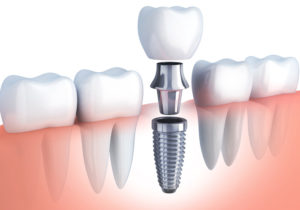A dental implant is a titanium post (like a tooth root) that is surgically positioned into the jawbone beneath the gum line that allows your dentist to mount replacement teeth or a bridge into that area. Dental implants also benefit general oral health because they do not have to be anchored to other teeth, like bridges.
If you are considering implants, you must have healthy gums and adequate bone to support the implant. If your bone is too thin or soft and unable to support an implant, you may require a bone graft. Or if there is not enough bone height in the upper jaw or the sinuses are too close to the jaw, you may require a sinus lift.
How Do They Work?
An implant-restored tooth consists of several parts.
- The implant, which is made of titanium, is placed in the upper or lower jawbone.
- The abutment can be made of titanium, gold or porcelain. It is attached to the implant with a screw. This part connects the implant to the crown. It is shaped like a natural tooth that has been cut down to receive a crown.
- The restoration (the part that looks like a tooth) is a crown. It usually is made of porcelain fused to a metal alloy (PFM). It also can be all metal or all porcelain. The crown is screwed or cemented onto the abutment. If the crown is screwed to the abutment, the screw hole will be covered with restorative material such as tooth-colored filling material (composite).
Initial consultation
Before any work is done, you will visit either a specialist called a prosthodontist or a general dentist who has had advanced training in the placement and restoration of implants.
Your dentist will do a comprehensive examination. During the exam, he or she will review your medical and dental history and take X-rays. In some cases, the dentist also may order a computed tomography (CT) scan of your mouth. This scan will help your dentist determine how much jawbone is available to hold the implants in place. It also will show the location of structures such as nerves and sinuses so they can be avoided during surgery.
If the X-rays show that your jaw does not have enough bone to hold an implant, the dentist can discuss options for building up the bone. These may include bone grafting. Grafting involves taking bone from another source and adding it to your jaw. A graft could be your own bone, from your mouth, chin or hip. Processed cadaver, cow or pig bone also can be used. Another option is a synthetic material such as hydroxyapatite or calcium phosphate.
If you need one of these procedures, it will take about 4 to 12 months for the bone to be ready for the implant.
First surgery — implant placement
Next, you’ll be ready for getting the implant, which is the metal screw that goes into your bone and acts as the anchor for the whole prosthesis. This procedure can take 1-2 hours and you’ll be asleep the whole time thanks to anesthesia.
After you’ve had the implant placed in your jawbone, the healing process can take up to five months for the lower jaw and up to seven months for the upper jaw. Once your mouth is healed, you’ll be ready for the next stage.
Placing The Healing Collar And/Or Temporary Crown
After the implants have fused with your jawbone, you’re ready for the next stage, which is getting a healing collar and possibly a temporary crown.
The dentist will place the healing collar (also called a healing cap) on the head of the implant — this helps guide the gum tissue in the proper way to heal. It’s a round piece of metal that keeps the gums away from the implant. This collar will stay on for 10-14 days.
After this time, in which your tissue should have healed, the dentist will remove it and move onto the next step.
Placing The Abutment
Next comes the abutment, which is the part that screws into the implant and will support the crown. Once the abutment is placed, your dentist will take another impression of the abutment for each replacement tooth.
Then you’ll get a temporary crown while your tissues continue to heal and form around the artificial tooth as with your natural teeth. You will wear the temporary crown for four to six weeks. During this time, your permanent crown will be made.
Placing The Permanent Crown
Now for the final stage of the procedures — placing the crown. Crowns, which are the tooth-looking part, can either be screwed into the abutment or cemented in place. The latter option typically looks better and more natural as there is no screw hole, which can be visible at certain angles.



